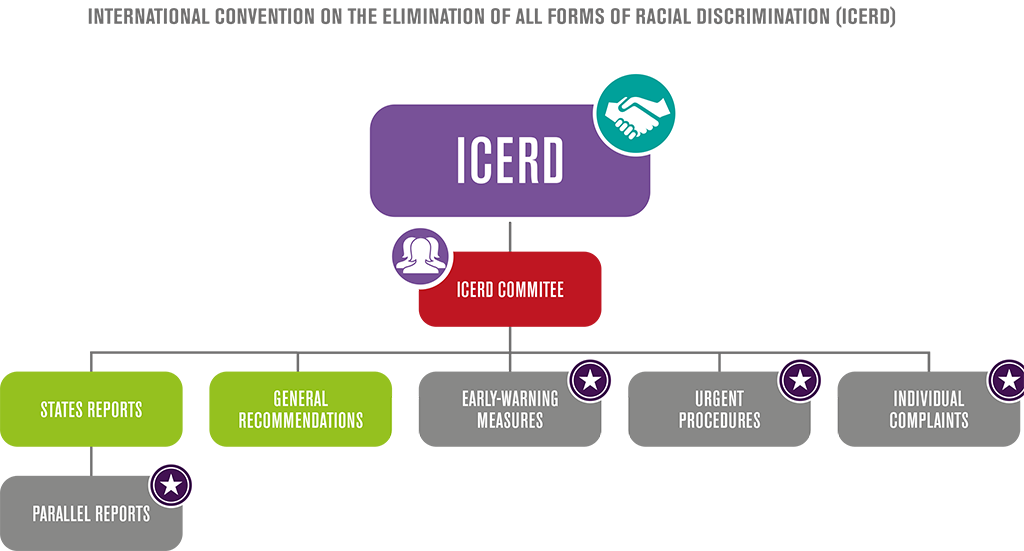



ICERD | ICERD Committee | States Reports | Parallel Reports | General Recommendations | Early-Warning Measures | Urgent Procedures | Individual complaints
At a glance
Treaty: International Convention on the Elimination of All Forms of Racial Discrimination (ICERD)
Entered into force: 4 January 1969
Optional Protocol(s): None
Treaty Body: Committee on the Elimination of Racial Discrimination (CERD)
Location: Geneva
Meetings: Twice a year
Reports to: General Assembly, through Secretary-General
States must report: Within one year of ratification, and every two years afterwards, and when requested by the Committee.
Has your state ratified it? ICERD
 International Convention on the Elimination of All Forms of Racial Discrimination (ICERD)
International Convention on the Elimination of All Forms of Racial Discrimination (ICERD)
Entered into force: 4 January 1969
The International Convention on the Elimination of All Forms of Racial Discrimination (ICERD) was adopted by the United Nations General Assembly (Resolution 2016) on 21 December 1965. It is an international treaty dedicated to tackling all forms of racial discrimination, outlining the rights of racial and/or ethnic groups or individuals that need to be guaranteed if everyone is to have equal enjoyment of their human rights and fundamental freedoms.
Women who identify with marginalised racial or ethnic groups often experience certain forms of racial discrimination differently than men. The ‘gender dimensions’ of racial discrimination have been increasingly recognised since the adoption of ICERD and states parties are now required to incorporate gender analysis into their reports on the implementation of the treaty – which will include the relationship between VAW and racial discrimination.
 Committee on the Elimination of Racial Discrimination (CERD)
Committee on the Elimination of Racial Discrimination (CERD)
The Committee on the Elimination of Racial Discrimination (CERD) is the independent expert body appointed to oversee states parties’ implementation of the ICERD. It consists of 18 independent experts who are nationals of states parties to ICERD. They are elected by secret ballot and serve four-year terms. CERD meets twice annually.
General Recommendations
In its General Recommendations, the Committee has addressed gender-based violence in relation to specific provisions in the ICERD and state responsibility to end it.
Determined to combat all forms of discrimination in the administration and functioning of the criminal justice system which may be suffered, in all countries of the world, by persons belonging to racial or ethnic groups, in particular non-citizens – including immigrants, refugees, asylum-seekers and stateless persons – Roma/Gypsies, indigenous peoples, displaced populations, persons discriminated against because of their descent, as well as other vulnerable groups which are particularly exposed to exclusion, marginalization and non-integration in society, paying particular attention to the situation of women and children belonging to the aforementioned groups, who are susceptible to multiple discrimination because of their race and because of their sex or their age; the Committee formulated the following recommendations…
…
41. Lastly, with regard to women and children belonging to the groups referred to in the last paragraph of the preamble, States parties should pay the greatest attention possible with a view to ensuring that such persons benefit from the special regime to which they are entitled in relation to the execution of sentences, bearing in mind the particular difficulties faced by mothers of families and women belonging to certain communities, particularly indigenous communities.
6. [Regarding general measures, States should] take into account, in all programmes and projects planned and implemented and in all measures adopted, the situation of Roma women, who are often victims of double discrimination.
…
22. To ensure that their programmes, projects and campaigns in the field of education take into account the disadvantaged situation of Roma girls and women.
…
34. To initiate and implement programmes and projects in the field of health for Roma, mainly women and children, having in mind their disadvantaged situation due to extreme poverty and low level of education, as well as to cultural differences; to involve Roma associations and communities and their representatives, mainly women, in designing and implementing health programmes and projects concerning Roma groups.
2. Certain forms of racial discrimination may be directed towards women specifically because of their gender, such as sexual violence committed against women members of particular racial or ethnic groups in detention or during armed conflict; the coerced sterilization of indigenous women; abuse of women workers in the informal sector or domestic workers employed abroad by their employers. Racial discrimination may have consequences that affect primarily or only women, such as pregnancy resulting from racial bias motivated rape; in some societies women victims of such rape may also be ostracized. Women may also be further hindered by a lack of access to remedies and complaint mechanisms for racial discrimination because of gender related impediments, such as gender bias in the legal system and discrimination against women in private spheres of life.
![]() Interested in other general comments? Browse all of the CERD’s general comments on the OHCHR website
Interested in other general comments? Browse all of the CERD’s general comments on the OHCHR website
States Reports
According to the Guidelines for the CERD-specific document, 13 June 2008:
6. On women, bearing in mind general recommendation No. 25 (2000) on gender-related dimensions of racial discrimination. States parties are requested to describe, as far as possible in quantitative and qualitative terms, factors affecting and difficulties experienced in ensuring the equal enjoyment by women, free from racial discrimination, of rights under the Convention. They should provide data by race, colour, descent and national or ethnic origin, which are then disaggregated by gender within those groups.
Particular attention should be brought to complex forms of disadvantage in which racial discrimination is mixed with other causes of discrimination (such as those based on age, sex and gender, religion, disability and low socio-economic status). States parties are asked to bear in mind the circumstances of the persons concerned, and to refer to any available social indicators of forms of disadvantage that may be linked with racial discrimination.
![]() Want more? Read the full guidelines on states reporting on the OHCHR website
Want more? Read the full guidelines on states reporting on the OHCHR website
![]() Parallel Reports
Parallel Reports
While state reports tend to provide information on legislative framework, they may not always thoroughly reflect the reality on the ground: for example, they may focus on domestic law, even though the implementation of that law for rights-holders may not be effective in practice. The Committee invites input from civil society to be used in their review of states’ reports (see section immediately above).This gives civil society actors the opportunity to present alternative evidence, views, findings and/or raise issues that are not covered by the state report. This input is submitted in the form of a report and parallel to the state report concerned. These reports are often referred to as “shadow reports” or “parallel reports”.
Interested in submitting a parallel report to the Committee?
 Case Study: Black Women’s Blueprint
Case Study: Black Women’s Blueprint
‘Racial discrimination and sexual violence against women of color, including those identifying as LGBTQ, and the impact of inadequate racial justice initiatives and violence prevention policy implementation in the United States’
Because states parties to ICERD are required to report on the gender-related dimensions of racial discrimination (including VAW), CSOs may also include information on VAW in their parallel reports to CERD. This gives CSOs an opportunity to respond to any gaps in states report and call attention to specific aspects of VAW that remain inadequately addressed.
In this first parallel report submitted by Black Women’s Blueprint, the organisation was able to draw CERD’s attention to specific United States’ laws and federal initiatives which “inadequately or do not address racial discrimination and gender-based violence against women of colour.” Following the submission of this report (in combination with other parallel reports submitted by NGOs/CSOs), CERD issued concluding observations on 25 September 2014 that identified ‘Violence against women’ as a key area of concern:
19. While acknowledging the measures taken by the State party to reduce the prevalence of violence against women, the Committee remains concerned at the disproportionate number of women from racial and ethnic minorities, particularly African American women, immigrant women and American Indian and Alaska Native women, who continue to be subjected to violence, including rape and sexual violence.”
The Committee calls upon the State party to intensify its efforts to prevent and combat violence against women, particularly American Indian and Alaska Native women, and ensure that all cases of violence against women are effectively investigated, perpetrators are prosecuted and sanctioned, and victims are provided with appropriate remedies. It also urges the State party to take measures to guarantee, in law and in practice, the right to access justice and effective remedies for all indigenous women who are victims of violence. It also reiterates its previous recommendation that the State party provide sufficient resources for violence prevention and service programmes; provide specific training for those working within the criminal justice system, including police officers, lawyers, prosecutors, judges and medical personnel; and undertake awareness-raising campaigns on the mechanisms and procedures available to seek remedies for violence against women.
![]() Want more?
Want more?
![]() Individual Complaints
Individual Complaints
Individual complaints concerning VAW are often submitted to the Committee on the Elimination of all forms of Discrimination against Women, however cases involving multiple levels of discrimination can be submitted to other treaty bodies. Mainstreaming gender throughout the work of all treaty bodies can raise awareness on and establish state accountability for the different forms VAW can take. It also calls attention to the difference in lived experiences among women and the unique vulnerabilities each face. In Kell v. Canada (19/2008) the Committee on the Elimination of all forms of Discrimination against Women found that Cecilia Kell suffered violence not only because she was a woman, but because she was an indigenous woman. This implies that Kell suffered discrimination at multiple levels: 1. Gender-based discrimination; 2. racial discrimination.
In order to submit an individual complaint, the state party concerned must have recognised the competency of the Committee according to Article 14 of the ICERD.
Interested in submitting an individual complaint to the Committee?
Check if your state has made a declaration under Article 14 | Complaint Guidelines
Complaint Form | ICERD Case Database
![]() Early-Warning Measures
Early-Warning Measures
Early Warning Measures can be taken by the Committee to prevent existing problems from escalating into conflicts. These can also include confidence-building measures to identify and support any action that improves the livelihood of the concerned group and prevents a resurgence of conflict where it has previously occurred.
Interested in submitting information to the Committee?
Guidelines (at the bottom of the page)
![]() Urgent Procedures
Urgent Procedures
Urgent Action Procedures allow the Committee to respond to problems requiring immediate attention to prevent or limit the scale or number of serious violations of the ICERD.
Criteria for initiating an urgent procedure includes:
- The presence of a serious, massive or persistent pattern of racial discrimination
- A serious situation where there is a risk of further racial discrimination
Interested in submitting information to the Committee?
Guidelines (at the bottom of the page)
For more information on engaging with the UN treaty bodies, see ‘Working with the United Nations Programme: A Handbook for Civil Society‘

